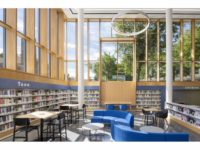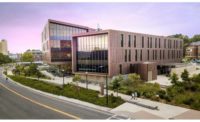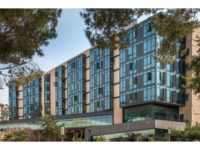Vitro Architectural Glass announced that three of the 10 buildings selected by the American Institute of Architects (AIA) Committee on the Environment (COTE®) as the top green building projects of 2021 were glazed with Solarban® solar control, low-emissivity glasses. The award-winning projects include:
- Rockwell Integrated Sciences Center; Lafayette College; Easton, Pennsylvania – Designed by Boston-based Payette, the 103,000-square-foot structure replaced the college’s energy-intensive biology building with a LEED® Platinum-certified office and classroom center. Featuring an open, airy “vertical commons,” daylit with energy-efficient Solarban® 70 glass, the new science building combines an array of energy-saving products and strategies to generate a predicted EUI (Energy Use Index) of 76 kBtu per square-foot, per year, which places it in the 99th percentile for energy performance among cold-climate labs. Constructed as part of a campus-wide initiative to reduce carbon emissions, the project produced a net 40% reduction in operating carbon emissions compared to the existing biology building.
- Hayden Library Reinvention; Arizona State University; Tempe, Arizona – A campus landmark since 1966, the Hayden Library at Arizona State University was completely re-imagined by architectural firm Ayers Saint Gross to function as a model of sustainable design while retaining its cherished architectural heritage. Double-height insulating glass units (IGUs) fabricated with Solarban® 70 glass highlight a new ground-level plaza that reconnects the library tower to the surrounding campus community. Salvaged granite panels and stained glass characterize the façade above the plaza, which features new double-pane IGUs fabricated with Solarban® 70 glass as energy performance upgrades to the library’s existing single-pane glazing. Combined with LED lighting, demand-controlled ventilation and a rooftop solar array, the glass enables the building to achieve an EUI of 42 kBtu per square-foot, per year, a 32% reduction in energy use compared to its pre-renovation performance.
- Life Sciences Building; University of Washington; Seattle – Building integrated photovoltaic (BIPV) panels and a highly transparent glass façade fabricated with Solarban® 72 Starphire® glass are signature design elements for the new Life Sciences Building at the University of Washington. Designed by Perkins+Will, the 12,400 square-foot, seven-story building achieves its sparkling jewel-box design despite a deceptively narrow 48.2% window-to-wall ratio (WWR) that helps reduce energy use by 80 percent compared to baseline structures of its type.
Featuring a proprietary triple-silver, solar control, low-e coating, Solarban® 70 glass combines visible light transmittance (VLT) of 64% with a solar heat gain coefficient (SHGC) of 0.27 in a standard one-inch IGU. Solarban® 72 Starphire® glass unites the same coating technology with Vitro Glass’s premium low-iron glass to achieve heightened levels of clarity and solar control performance. In a standard one-inch IGU, Solarban® 72 Starphire® glass has VLT of 68% and a SHGC of 0.28.
For more information about the full range of sustainable architectural glass products available from Vitro Architectural Glass, please visit www.vitroglazings.com or call 1-855-VTRO-GLS (887-6457). Information on satisfying LEED and other green building objectives with Vitro Glass products is available at www.vitroglazings.com/leed.



